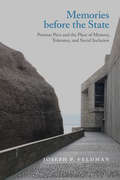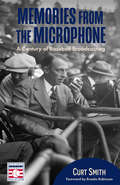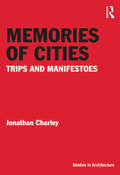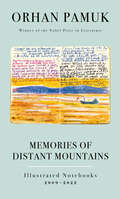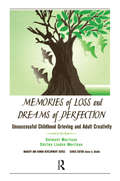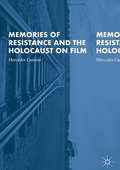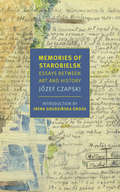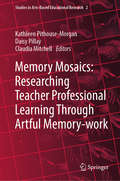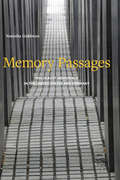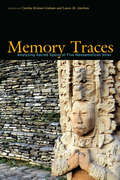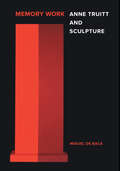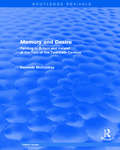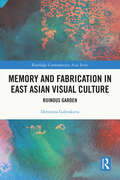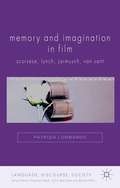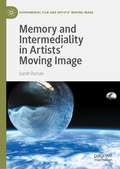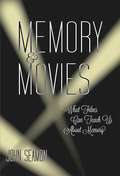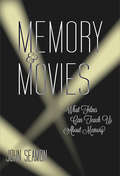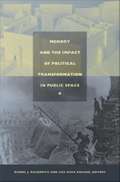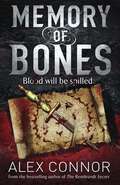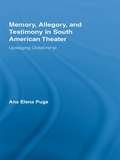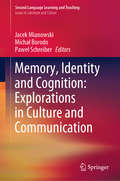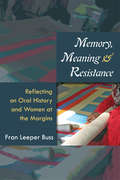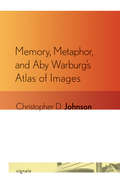- Table View
- List View
Memories before the State: Postwar Peru and the Place of Memory, Tolerance, and Social Inclusion (Genocide, Political Violence, Human Rights)
by Joseph P. FeldmanMemories before the State examines the discussions and debates surrounding the creation of the Place of Memory, Tolerance, and Social Inclusion (LUM), a national museum in Peru that memorializes the country’s internal armed conflict of the 1980s and 1990s. Emerging from a German donation that the Peruvian government initially rejected, the Lima-based museum project experienced delays, leadership changes, and limited institutional support as planners and staff devised strategies that aligned the LUM with a new class of globalized memorial museums and responded to political realities of the country’s postwar landscape. The book analyzes forms of authority that emerge as an official institution seeks to incorporate and manage diverse perspectives on recent violence.
Memories from the Microphone: A Century of Baseball Broadcasting
by Curt SmithVoices of the GameCurt Smith is “…the voice of authority on baseball broadcasting.” —USA Today#1 New Release in Photography, Baseball Statistics, Photo Essays, and Photojournalism In this second in a series of Baseball Hall of Fame books, celebrate the larger-than-life role played by radio and TV baseball announcers in enhancing the pleasure of our national pastime.Commemorate the 100th anniversary of baseball broadcasting. The first baseball game ever broadcast on radio was on August 5, 1921 by Harold Wampler Arlin, a part-time baseball announcer on Pittsburgh’s KDKA, America’s first commercially licensed radio station. The Pirates defeated the Phillies 8-5.An insider’s view of baseball. Now you can own Memories from the Microphone and experience baseball from author Curt Smith. He has spent much of his life covering baseball radio and TV, and previously authored baseball books including the classic Voices of The Game.Relive baseball’s storied past through the eyes of famed baseball announcers. Organized chronologically, Memories from the Microphone charts the history of baseball broadcasting. Enjoy celebrated stories and personalities that have shaped the game—from Mel Allen to Harry Caray, Vin Scully to Joe Morgan, Ernie Harwell to Red Barber.Also discover:Images from the Baseball Hall of Fame’s matchless archiveAnecdotes and quotes from Curt Smith’s original researchInterviews with broadcast greatsLittle-known stories, such as Ronald Reagan calling games for WHO Des Moines in the 1930sAccounts of diversity in baseball broadcasting, including the TV coverage of Joe Morgan and earlier Hispanic pioneers Buck Canel and Rafael (Felo) RamirezA special section devoted to the Ford C. Frick Award and inductees since its inception in 1978Also take a nostalgic trip down baseball's memory lane with other Baseball Hall of Fame books: Picturing America’s Pastime, So You Think You Know Baseball, and Baseball Memories and Dreams.
Memories of Cities: Trips and Manifestoes (Ashgate Studies In Architecture Ser.)
by Jonathan CharleyMemories of Cities is a collection of essays that explore different ways of writing about the political and economic history of the built environment. Drawing upon fiction and non-fiction, and illustrated by original photographs, the essays employ a variety of narrative forms including memoirs, letters, and diary entries. They take the reader on a journey to cities such as Glasgow, Paris, Moscow, St. Petersburg, and Marseille, laying bare the contradictions of capitalist architectural and urban development, whilst simultaneously revealing alternative visions of how buildings and cities might be produced and organised.
Memories of Distant Mountains: Illustrated Notebooks, 2009-2022
by Orhan PamukWINNER OF THE NOBEL PRIZE IN LITERATURE • Beautiful, full-colour selections from Orhan Pamuk&’s selected art notebooks.&“One of the world's finest living writers.&” The Independent&“In this world of forgeries, where some might be in danger of losing their faith in literature, Pamuk is the real thing.&” The ObserverFor many years, Orhan Pamuk kept a record of his daily thoughts and observations, entering them in small notebooks and illustrating them with his own paintings. This book combines those notebooks into one volume. He writes about his travels around the world, his family, his writing process, and his complex relationship with his home country of Turkey. He charts the seeds of his novels and the things that inspired his characters and the plots of his stories. Intertwined in his writings are the vibrant paintings of the landscapes that surround and inspire him.A beautiful object in its own right, in Memories of Distant Mountains readers can explore Pamuk's intoxicating inner world and can have a fascinating, intimate encounter with the art, culture, and charged political currents that have shaped one of literature&’s most important voices.
Memories of Distant Mountains: Illustrated Notebooks, 2009-2022
by Orhan PamukThe journals of the Nobel Prize–winning author, beautifully illustrated with his own paintingsFor many years, Orhan Pamuk kept a record of his daily thoughts and observations, entering them in small notebooks and illustrating them with his own paintings. This book combines those notebooks into one volume. He writes about his travels around the world, his family, his writing process, and his complex relationship with his home country of Turkey. He charts the seeds of his novels and the things that inspired his characters and the plots of his stories. Intertwined in his writings are the vibrant paintings of the landscapes that surround and inspire him.A beautiful object in its own right, in Memories of Distant Mountains readers can explore Pamuk's intoxicating inner world and can have a fascinating, intimate encounter with the art, culture, and charged political currents that have shaped one of literature&’s most important voices.
Memories of Loss and Dreams of Perfection: Unsuccessful Childhood Grieving and Adult Creativity
by Delmont C Morrison Shirley Linden MorrisonWith "Memories of Loss and Dreams of Perfection", Delmont and Shirley Morrison have made an impressive contribution to psychology and to the appreciation of literature by demonstrating the ways in which a children's imaginative play can help them cope with the tragic early loss of beloved family members and by tracing how such early play processes form the basis for adult creativity. Their book is unique in that it: presents new ideas and expands our understanding of the complex interrelationships among loss, child development and creativity, and presents clinical cases of play therapy and case studies of creative adults to illustrate theory and concepts. The Morrisons incorporate scientific research, clinical case studies, and biographies in a manner that provides a deeper understanding of the fiction of Emily Bronte, J.M. Barrie, Jack Kerouac and Isak Dinesen. Readers will be deeply touched and moved to self-exploration by the humanity and sensitivity of this fine book.
Memories of Resistance and the Holocaust on Film
by Mercedes CaminoThis book investigates cinematic representations of the murder of European Jews and civilian opposition to Nazi occupation from the war up until the twenty-first century. The study exposes a chronology of the conflict’s memorialization whose geo-political alignments are demarcated by vectors of time and space—or ‘chronotopes’, using Mikhail Bakhtin’s term. Camino shows such chronotopes to be first defined by the main allies; the USA, USSR and UK; and then subsequently expanding from the geographical and political centres of the occupation; France, the USSR and Poland. Films from Western and Eastern Europe and the USA are treated as primary and secondary sources of the conflict. These sources contribute to a sentient or emotional history that privileges affect and construct what Michel Foucault labels biopolitics. These cinematic narratives, which are often based on memoirs of resistance fighters like Joseph Kessel or Holocaust survivors such as Primo Levi and Wanda Jakubowska, evoke the past in what Marianne Hirsch has described as ‘post-memory’.
Memories of Starobielsk: Essays Between Art and History
by Jozef CzapskiVivid accounts of life in a Soviet prison camp by the author of Inhuman Land.Interned with thousands of Polish officers in the Soviet prisoner-of-war camp at Starobielsk in September 1939, Józef Czapski was one of a very small number to survive the massacre in the forest of Katyń in April 1940. Memories of Starobielsk portrays these doomed men, some with the detail of a finished portrait, others in vivid sketches that mingle intimacy with respect, as Czapski describes their struggle to remain human under hopeless circumstances. Essays on art, history, and literature complement the memoir, showing Czapski&’s lifelong engagement with Russian culture. The short pieces on painting that he wrote while on a train traveling from Moscow to the Second Polish Army&’s strategic base in Central Asia stand among his most lyrical and insightful reflections on art.
Memory Mosaics: Researching Teacher Professional Learning Through Artful Memory-work (Studies in Arts-Based Educational Research #2)
by Claudia Mitchell Kathleen Pithouse-Morgan Daisy PillayThis book communicates new voices, insights, and possibilities for working with the arts and memory in researching teacher professional learning. The book reveals how, through the arts, teacher-researchers can reimagine and reinvigorate moments of the past as embodied and empowering scholarly experiences. The peer-reviewed chapters were composed from juxtaposing unique “mosaic” pieces written by 21 new and emerging scholars in South Africa and Canada. Their research explores diverse arts-based practices and resources including collage, film, drawing, narrative, poetry, photography, storytelling and television alongside related ethical issues. Critically, Memory Mosaics also demonstrates how artful memory-work can engender agency in professional learning with teacher-researchers taking up pressing issues of social justice such as inclusion and decolonisation. Overall, the book offers a multidimensional, polyvocal exploration of how artful memory-work can bring about future-oriented professional learning enacted as pedagogies of reinvention and productive remembering.Memory Mosaics: Researching Teacher Professional Learning Through Artful Memory-Work, by Kathleen Pithouse-Morgan, Daisy Pillay, and Claudia Mitchell, along with teacher-researchers on two continents, is a ground-breaking book. It models a collaborative approach to arts-based research that melds memory-work, visual and poetic arts, and reflective practice to promote professional learning, personal transformation, decolonisation, and a more just future. Like colourful pebbles and bits of glass, the authors place teachers’ self-stories in relation to one another in an artful design, creating thematic coherence that evokes a deep sense of knowing. Judith C. Lapadat, Professor Emeritus, Faculty of Education, University of Lethbridge, CanadaMemory Mosaics: Researching Teacher Professional Learning Through Artful Memory-Workassembles exemplars of professional learning in an intriguing mosaic format. A topic is introduced, followed by memory-pieces; then: discussion and/or creative response. This lively juxtaposition generates momentum for highly productive forms of remembering around social justice issues, even as the reader is invited into an intimate circle of shared concern: for these issues, with these (and other) teacher-researchers. It is a beautiful, original, and practical book. Teresa Strong-Wilson, Associate Professor, Faculty of Education, McGill University, Canada
Memory Passages: Holocaust Memorials in the United States and Germany
by Natasha GoldmanFor decades, artists and architects have struggled to relate to the Holocaust in visual form, resulting in memorials that feature a diversity of aesthetic strategies. In Memory Passages, Natasha Goldman analyzes both previously-overlooked and internationally-recognized Holocaust memorials in the United States and Germany from the postwar period to the present, drawing on many historical documents for the first time. From the perspectives of visual culture and art history, the book examines changing attitudes toward the Holocaust and the artistic choices that respond to it. The book introduces lesser-known sculptures, such as Nathan Rapoport’s Monument to the Six Million Jewish Martyrs in Philadelphia, as well as internationally-acclaimed works, such as Peter Eisenman’s Memorial to the Murdered Jews of Europe in Berlin. Other artists examined include Will Lammert, Richard Serra, Joel Shapiro, Gerson Fehrenbach, Margit Kahl, and Andy Goldsworthy.Archival documents and interviews with commissioners, survivors, and artists reveal the conversations and decisions that have shaped Holocaust memorials. Memory Passages suggests that memorial designers challenge visitors to navigate and activate spaces to engage with history and memory by virtue of walking or meandering. This book will be valuable for anyone teaching—or seeking to better understand—the Holocaust.
Memory Traces: Analyzing Sacred Space at Five Mesoamerican Sites
by Laura M. Amrhein Cynthia Kristan-GrahamIn Memory Traces, art historians and archaeologists come together to examine the nature of sacred space in Mesoamerica. Through five well-known and important centers of political power and artistic invention in Mesoamerica—Tetitla at Teotihuacan, Tula Grande, the Mound of the Building Columns at El Tajín, the House of the Phalli at Chichén Itzá, and Tonina—contributors explore the process of recognizing and defining sacred space, how sacred spaces were viewed and used both physically and symbolically, and what theoretical approaches are most useful for art historians and archaeologists seeking to understand these places. Memory Traces acknowledges that the creation, use, abandonment, and reuse of sacred space have a strongly recursive relation to collective memory and meanings linked to the places in question and reconciles issues of continuity and discontinuity of memory in ancient Mesoamerican sacred spaces. It will be of interest to students and scholars of Mesoamerican studies and material culture, art historians, architectural historians, and cultural anthropologists. Contributors: Laura M. Amrhein, Nicholas P. Dunning, Rex Koontz, Cynthia Kristan-Graham, Matthew G. Looper, Travis Nygard, Keith M. Prufer, Matthew H. Robb, Patricia J. Sarro, Kaylee Spencer, Eric Weaver, Linnea Wren
Memory Work: Anne Truitt and Sculpture
by Miguel de BacaMemory Work demonstrates the evolution of the pioneering minimalist sculptor Anne Truitt. An artist determined to make her way through a new aesthetic in the 1960s, Truitt was tireless in her pursuit of a strong cultural voice. At the heart of her practice was the key theme of memory, which enabled her not only to express personal experience but also to address how perception was changing for a contemporary viewership. She gravitated toward the idea that an object in one’s focus could unleash a powerful return to the past through memory, which in turn brings a fresh, even critical, attention to the present moment. In addition to the artist’s own popular published writings, which detail the unique challenges facing female artists, Memory Work draws on unpublished manuscripts, private recordings, and never-before-seen working drawings to validate Truitt’s original ideas about the link between perception and mnemonic reference in contemporary art. De Baca offers an insider’s view of the artist’s unstinting efforts to realize her artistic vision, as well as the cultural, political, and historical resonances her oeuvre has for us today.
Memory and Desire: Painting in Britain and Ireland at the Turn of the Twentieth Century (British Art And Visual Culture Since 1750: New Readings Ser.)
by Kenneth McConkeyThis title was first published in 2002. 'Memory and Desire' is a lavishly illustrated account of the art world in Britain at the turn of the twentieth century. It calls upon rich resources of contemporary diaries, letters and art criticism, as well as the analysis of works of art to answer questions about how and why new artistic tendencies emerged and tastes changed. Eschewing the familiar narrative of an inevitable progress towards modernism, Kenneth McConkey considers a broad range of art and critical thinking in the period. Discussing the market for old master paintings, which rivalled those for modern art, and the question of how and why certain genres of art were particularly successful at the time, McConkey explores the detail and significance of contemporary taste. He draws upon the work of commercially successful painters such as John Singer Sargent, William Orpen, George Clausen, Alfred East, John Lavery and Philip Wilson Steer, and their critic-supporters to throw light upon current arguments about training, aesthetics, visual memory and the creation of new art. 'Memory and Desire' is a major contribution to our knowledge of this important period in British art.
Memory and Fabrication in East Asian Visual Culture: Ruinous Garden (Routledge Contemporary Asia Series)
by Dennitza GabrakovaThis book examines four contemporary sites of visual culture in East Asia through the poetic prism of the “ruinous garden.” Framing destroyed, discarded, and displaced material objects within a rhetoric of development and relating this to the experience of ethnic/national culture, the book presents succinct analyses of visual works, as well as cultural criticisms, centered on space in metropolitan Japan and Hong Kong, China. These analyses are placed in dialog with approaches from postcolonial texts, addressing development and fractures in representation. Additionally, the book suggests graphic design as a form of retrospective cultural thinking, encompassing visual and invisible modernity, as well as an attachment to disappearing space. Offering a unique and thorough analysis of Japanese visual culture, combining discussion on photography, installation art, and graphic design, as well as integrating material from Hong Kong visual culture in discussions of identity, this book will appeal to students and scholars of visual culture in East Asia, environmental art, and environmental humanities.
Memory and Imagination in Film: Scorsese, Lynch, Jarmusch, Van Sant (Language, Discourse, Society)
by Lynch Scorsese Jarmusch Van SantInspired by Baudelaire's art criticism and contemporary theories of emotions, and developing a new aesthetic approach based on the idea that memory and imagination are strongly connected, Lombardo analyzes films by Scorsese, Lynch, Jarmusch and Van Sant as imaginative uses of the history of cinema as well as of other media.
Memory and Intermediality in Artists’ Moving Image (Experimental Film and Artists’ Moving Image)
by Sarah DurcanThis book addresses the preoccupation with memory in contemporary artists’ moving image installations. It situates artists’ moving image in relation to the transformations of digitalization as hybrid intermedial combinations of analogue film, video and digital video emerge from mid 1990s onwards. While film has always been closely associated with the process of memory, this book investigates new models of memory in artists’ remediation of film with video and other intermedial aesthetics. Beginning with a chapter on the theorization of memory and the moving image and the diverse genealogies of artists’ film and video, the following chapters identify five different mnemonic modes in artists’ moving image: critical nostalgia, database narrative, the ‘echo-chamber’, documentary fiction and mediatized memories. Stan Douglas, Steve McQueen, Runa Islam, Mark Leckey and Elizabeth Price are of a generation that has lived through the transition from analogue to digital. Their emphasis on the nuances of intermediality indicates the extent to which we remember through media.
Memory and Movies
by John SeamonIn the movie Slumdog Millionaire, the childhood memories of a young game show contestant trigger his correct answers. In Memento, the amnesiac hero uses tattoos as memory aids. In Away from Her, an older woman suffering from dementia no longer remembers who her husband is. These are compelling films that tell affecting stories about the human condition. But what can these movies teach us about memory? In this book, John Seamon shows how examining the treatment of memory in popular movies can shed new light on how human memory works. After explaining that memory is actually a diverse collection of independent systems, Seamon uses examples from movies to offer an accessible, nontechnical description of what science knows about memory function and dysfunction. In a series of lively encounters with numerous popular films, he draws on Life of Pi and Avatar, for example, to explain working memory, used for short-term retention. He describes the process of long-term memory with examples from such films as Cast Away and Groundhog Day; The Return of Martin Guerre, among other movies, informs his account of how we recognize people; the effect of emotion on autobiographical memory is illustrated by The Kite Runner, Titanic, and other films; movies including Born on the Fourth of July and Rachel Getting Married illustrate the complex pain of traumatic memories. Seamon shows us that movies rarely get amnesia right, often using strategically timed blows to the protagonist's head as a way to turn memory off and then on again (as in Desperately Seeking Susan). Finally, he uses movies including On Golden Pond and Amour to describe the memory loss that often accompanies aging, while highlighting effective ways to maintain memory function.
Memory and Movies: What Films Can Teach Us about Memory (The\mit Press Ser.)
by John SeamonHow popular films from Memento to Slumdog Millionaire can help us understand how memory works.In the movie Slumdog Millionaire, the childhood memories of a young game show contestant trigger his correct answers. In Memento, the amnesiac hero uses tattoos as memory aids. In Away from Her, an older woman suffering from dementia no longer remembers who her husband is. These are compelling films that tell affecting stories about the human condition. But what can these movies teach us about memory? In this book, John Seamon shows how examining the treatment of memory in popular movies can shed new light on how human memory works. After explaining that memory is actually a diverse collection of independent systems, Seamon uses examples from movies to offer an accessible, nontechnical description of what science knows about memory function and dysfunction. In a series of lively encounters with numerous popular films, he draws on Life of Pi and Avatar, for example, to explain working memory, used for short-term retention. He describes the process of long-term memory with examples from such films as Cast Away and Groundhog Day; The Return of Martin Guerre, among other movies, informs his account of how we recognize people; the effect of emotion on autobiographical memory is illustrated by The Kite Runner, Titanic, and other films; movies including Born on the Fourth of July and Rachel Getting Married illustrate the complex pain of traumatic memories. Seamon shows us that movies rarely get amnesia right, often using strategically timed blows to the protagonist's head as a way to turn memory off and then on again (as in Desperately Seeking Susan). Finally, he uses movies including On Golden Pond and Amour to describe the memory loss that often accompanies aging, while highlighting effective ways to maintain memory function.
Memory and the Impact of Political Transformation in Public Space
by Daniel J. Walkowitz Lisa Maya KnauerMemory and the Impact of Political Transformation in Public Space explores the effects of major upheavals--wars, decolonization, and other social and economic changes--on the ways in which public histories are presented around the world. Examining issues related to public memory in twelve countries, the histories collected here cut across political, cultural, and geographic divisions. At the same time, by revealing recurring themes and concerns, they show how basic issues of history and memory transcend specific sites and moments in time. A number of the essays look at contests over public memory following two major political transformations: the wave of liberation from colonial rule in much of Africa, Asia, and Central and South America during the second half of the twentieth century and the reorganization of Eastern Europe and the former Soviet bloc beginning in the late 1980s. This collection expands the scope of what is considered public history by pointing to silences and absences that are as telling as museums and memorials. Contributors remind us that for every monument that is erected, others--including one celebrating Sri Lanka's independence and another honoring the Unknown Russian Soldier of World War II--remain on the drawing board. While some sites seem woefully underserved by a lack of public memorials--as do post-Pinochet Chile and post-civil war El Salvador--others run the risk of diluting meaning through overexposure, as may be happening with Israel's Masada. Essayists examine public history as it is conveyed not only in marble and stone but also through cityscapes and performances such as popular songs and parades. Contributors James Carter John Czaplicka Kanishka Goonewardena Lisa Maya Knauer Anna Krylova Teresa Meade Bill Nasson Mary Nolan Cynthia Paces Andrew Ross Daniel Seltz T. M. Scruggs Irina Carlota Silber Daniel J. Walkowitz Yael Zerubavel
Memory of Bones
by Alex ConnorThe head of Francisco Goya was stolen from his tomb in the wake of his death. No one has ever known what happened to it. Until now. Leon Golding has always been ignored by the art world he loves, but he's finally going to make his name as the man who found the skull of Goya. But he's asked the wrong people to help him prove he's right. Now everyone wants to own the most prized piece of art history ever to come to light . . . And they're ready to kill for it.
Memory, Allegory, and Testimony in South American Theater: Upstaging Dictatorship (Routledge Advances in Theatre & Performance Studies #Vol. 8)
by Ana Elena PugaMemory, Allegory, and Testimony in South American Theater traces the shaping of a resistant identity in memory, its direct expression in testimony, and its indirect elaboration in two different kinds of allegory. Each chapter focuses on one contemporary playwright (or one collaborative team, in the case of Brazil) from each of four Southern Cone countries and compares the playwrights’ aesthetic strategies for subverting ideologies of dictatorship: Carlos Manuel Varela (memory in Uruguay), Juan Radrigán (testimony in Chile), Augusto Boal and his co-author Gianfrancesco Guarnieri (historical allegory in Brazil), Griselda Gambaro (abstract allegory in Argentina).
Memory, Identity and Cognition: Explorations in Culture and Communication (Second Language Learning and Teaching)
by Michał Borodo Jacek Mianowski Paweł SchreiberThe book analyses a variety of topics and current issues in linguistics and literary studies, focusing especially on such aspects as memory, identity and cognition. Firstly, it discusses the notion of memory and the idea of reimagining, as well as coming to terms with the past. Secondly, it studies the relationship between perception, cognition and language use. It then investigates a variety of practices of language users, language learners and translators, such as the use of borrowings from hip-hop and slang. The book is intended for researchers in the fields of linguistics and literary studies, lecturers teaching undergraduate and master’s students on courses in language and literature.
Memory, Meaning, and Resistance: Reflecting on Oral History and Women at the Margins
by Fran Leeper BussFran Leeper Buss, a former welfare recipient who earned a PhD in history and became a pioneer in the field of oral history, has for forty years dedicated herself to the goal of collecting the stories of marginal and working-class U.S. women. Memory, Meaning, and Resistance is based on over 100 oral histories gathered from women from a variety of racial, ethnic, and geographical backgrounds, including a traditional Mexican American midwife, a Latina poet and organizer for the United Farm Workers, and an African American union and freedom movement organizer. Buss now analyzes this body of work, identifying common themes in women’s lives and resistance that unite the oral histories she has gathered. From the beginning, her work has shed light on the inseparable, compounding effects of gender, race, ethnicity, and class on women’s lives—what is now commonly called intersectionality. Memory, Meaning, and Resistance is structured thematically, with each chapter analyzing a concept that runs through the oral histories, e.g., agency, activism, religion. The result is a testament to women’s individual and collective strength, and an invaluable guide for students and researchers, on how to effectively and sensitively conduct oral histories that observe, record, recount, and analyze women’s life stories.
Memory, Metaphor, and Aby Warburg's Atlas of Images
by Christopher D. JohnsonThe work of German cultural theorist and art historian Aby Warburg (1866-1929) has had a lasting effect on how we think about images. This book is the first in English to focus on his last project, the encyclopedic Atlas of Images: Mnemosyne. Begun in earnest in 1927, and left unfinished at the time of Warburg's death in 1929, the Atlas consisted of sixty-three large wooden panels covered with black cloth. On these panels Warburg carefully, intuitively arranged some thousand black-and-white photographs of classical and Renaissance art objects, as well as of astrological and astronomical images ranging from ancient Babylon to Weimar Germany. Here and there, he also included maps, manuscript pages, and contemporary images taken from newspapers. Trying through these constellations of images to make visible the many polarities that fueled antiquity's afterlife, Warburg envisioned the Atlas as a vital form of metaphoric thought. While the nondiscursive, frequently digressive character of the Atlas complicates any linear narrative of its themes and contents, Christopher D. Johnson traces several thematic sequences in the panels. By drawing on Warburg's published and unpublished writings and by attending to Warburg's cardinal idea that "pathos formulas" structure the West's cultural memory, Johnson maps numerous tensions between word and image in the Atlas. In addition to examining the work itself, he considers the literary, philosophical, and intellectual-historical implications of the Atlas. As Johnson demonstrates, the Atlas is not simply the culmination of Warburg's lifelong study of Renaissance culture but the ultimate expression of his now literal, now metaphoric search for syncretic solutions to the urgent problems posed by the history of art and culture.
Memory: Shaping Connections in the Arts Therapies
by Richard Hougham Sarah Scoble Marián CaoMemory is compilation of scholarly chapters by authors of global reputation in the arts therapies.This international publication reflects the theme of the 16th International Conference of the European Consortium for Arts Therapies (ECArTE), held in Vilnius, Lithuania. Questions of memory go to the very heart of our making sense of the world. This book brings together wide-ranging chapters, which address the question of memory, designed to stimulate understanding and debate in contemporary arts therapy education, practice and research.Writers from Canada, Estonia, Germany, Iceland, Lebanon, Lithuania, Spain, the UK and the US combine to create a topical publication, incorporating diverse and current thinking in art therapy, dance movement therapy, dramatherapy and music therapy. In this innovative compilation, authors offer different cultural perspectives on the conception of memory which informs epistemology across the field of arts therapy.This book will be of interest and relevance to those in the arts therapy community and to a broader readership, including students and professionals in the disciplines of psychology, sociology, psychotherapy, the arts, medicine, integrated health and education.
